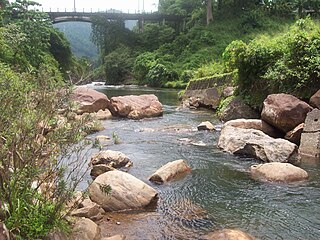
Victoria Dam is an arch dam located 130 mi (209 km) upstream of the Mahaweli River's mouth and 4 mi (6 km) from Teldeniya. It is named in honour of Queen Victoria of the United Kingdom.

The Samanala Dam is a dam primarily used for hydroelectric power generation in Sri Lanka. Commissioned in 1992, the Samanalawewa Project is the third-largest hydroelectric scheme in the country, producing 405 GWh of energy annually. It was built with financial support from Japan and the United Kingdom. It is notable for a large leak on its right bank. Power production continues as planned despite the leakage, and the water from the leak now provides two thirds of the water issued by the reservoir for agriculture in downstream areas.

The electricity sector in Sri Lanka has a national grid which is primarily powered by hydroelectric power and thermal power, with sources such as photovoltaics and wind power in early stages of deployment. Although potential sites are being identified, other power sources such as geothermal, nuclear, solar thermal and wave power are not used in the power generation process for the national grid.

The Upper Kotmale Dam is located in Talawakele, within the Nuwara Eliya District, in the Central Province of Sri Lanka. The dam feeds the third largest hydroelectric power station in the country.
Ukuwela is a large suburb of Matale, Sri Lanka. lt lies south about 5.5 kilometres (3.4 mi) from the Matale Municipal Council, area, located on the Wattegama-Matale Road.

The Randenigala Dam is a large hydroelectric embankment dam at Rantembe, in the Central Province of Sri Lanka. Construction of the dam began in November 1982, and was completed in approximately 4 years. The dam and power station was ceremonially opened by then President J. R. Jayawardene in 1986.
The Bowatenna Dam is a 100 ft (30 m) high gravity dam at Bowatenna, in Central Province of Sri Lanka. The dam was built in June 1981, and is used primarily for irrigation. A 40 MW power station is also constructed 5,800 ft (1,800 m) downstream, for hydroelectric power generation.

The Maskeliya Dam is a large gravity dam at Maskeliya, in the Central Province of Sri Lanka. Along with the Castlereigh Dam, the dams are the highest point and beginning of the Laxapana Hydropower Complex, involving a number of dams, penstocks, and hydroelectric power stations. The dam creates the Maskeliya Reservoir over the route of Maskeliya Oya, a major tributary of the Kelani River, which is the 4th longest in the country.

The Castlereigh Dam is a gravity dam built across the Kehelgamu Oya, a major tributary to the Kelani River, approximately 3 km (1.9 mi) south-west of Hatton, in the Central Province of Sri Lanka. The dam is a popular location for both locals and tourists.

The Norton Dam is the gravity dam built across the Kehelgamu Oya, which is a main tributary to the Kelani River. The dam is built at Norton Bridge, in the Central Province of Sri Lanka.

The Canyon Dam is a large arch-gravity dam built across the Maskeliya Oya, 4.5 km (2.8 mi) upstream of the iconic Laxapana Falls, in the Central Province of Sri Lanka. The associated power station plays a major role in the national power grid, due to its significant output. The dam is surrounded by steel structures of the substation.

The Laxapana Dam is a gravity dam built across the Maskeliya Oya, 2.8 km (1.7 mi) downstream of the Laxapana Falls, in the Central Province of Sri Lanka.

The Kehelgamu Oya is a major upstream tributary of the Kelani River. The tributary measures 50 km (31 mi) in length, originating in the hills of the Horton Plains National Park, before passing through the Castlereigh Reservoir. Kehelgamu Oya converges with the Maskeliya Oya at Kalugala, forming the 100 km (62 mi) long Kelani River. The river is heavily used for hydroelectric power generation.

The Maskeliya Oya is a major upstream tributary of the Kelani River. This 40 km (25 mi) long tributary originates in the hills of the Peak Wilderness Sanctuary, before passing through the Maskeliya Reservoir. The Maskeliya Oya converges with the Kehelgamu Oya at Kalugala, forming the 100 km (62 mi) long Kelani River. The river is heavily used for hydroelectric power generation.

The Udawalawe Dam is a large irrigation dam in Udawalawe, in the Southern Province of Sri Lanka. The dam consists of an embankment section and a gravity section, combining the total dam length to approximately 3.9 km (2.4 mi). The dam is also used for hydroelectric power generation, powering two 2 MW units, commissioned in April 1969.

The Gal Oya Dam is an embankment dam in the Uva Province of Sri Lanka. The dam creates one of the largest reservoirs in the country, the Gal Oya Reservoir. Water from the reservoir is used primarily for irrigation in the Uva and Eastern provinces, in addition to powering a small hydroelectric power station. Construction of the dam and reservoir began in August 24, 1949, completing four years later in 1953.
The Mahaweli Development program is known as the largest multipurpose national development program in the history of Sri Lanka and is also considered the keystone of the government's development program that was initiated in 1961.
The Moragolla Dam is a planned hydroelectric dam in Moragolla, Sri Lanka. The dam is to be 35 m (115 ft) high and is planned to create the 1,980,000 m3 (70,000,000 cu ft) Moragolla Reservoir with a maximum supply level at 548 m (1,798 ft) MSL. Upon completion, the Moragolla Power Station would have a gross installed capacity of 30 megawatts from two francis turbines, capable of generating approximately 85 GWh annually.
















